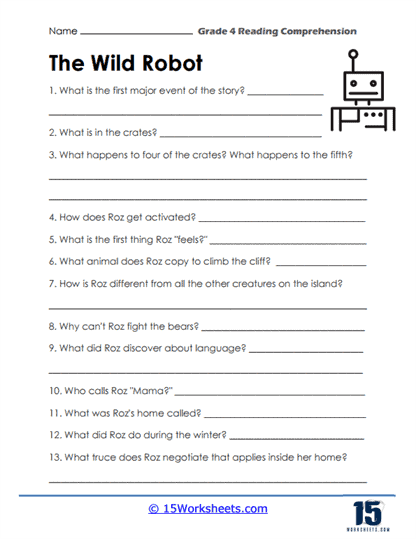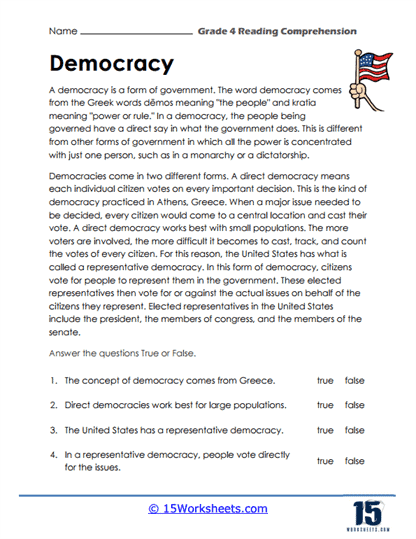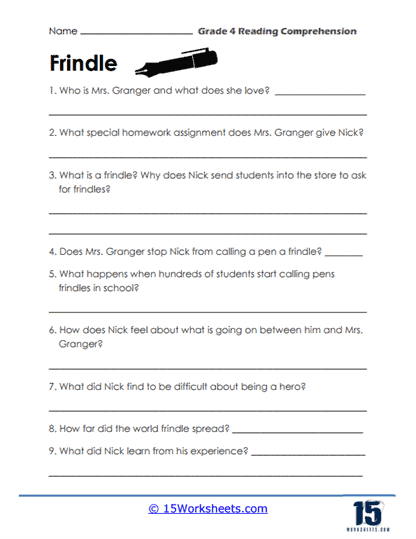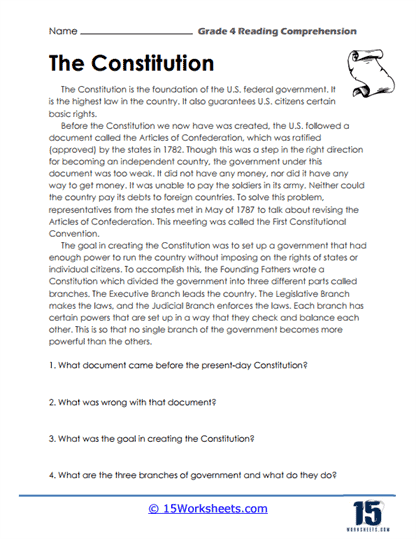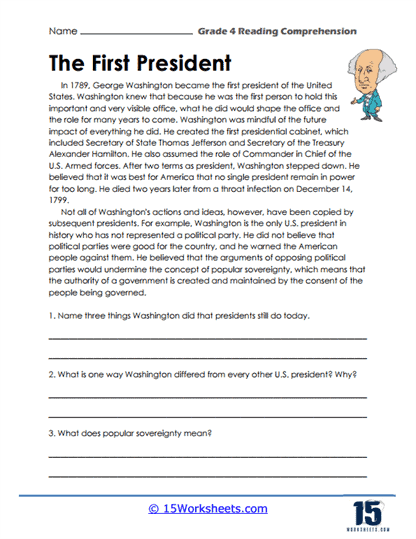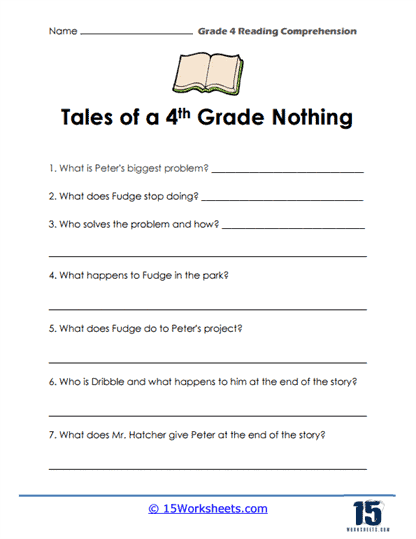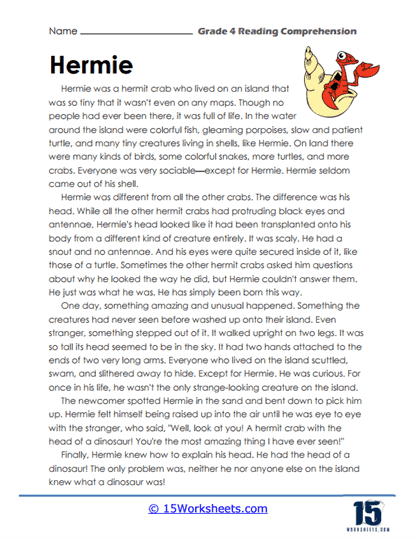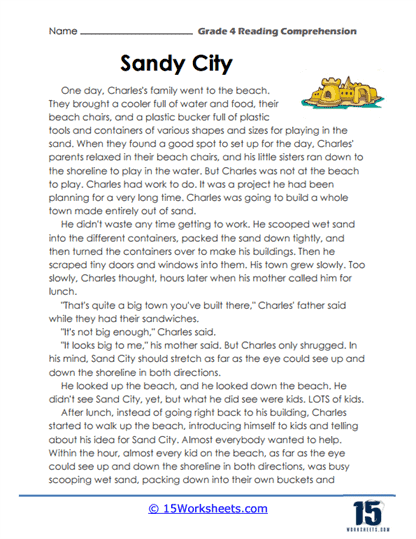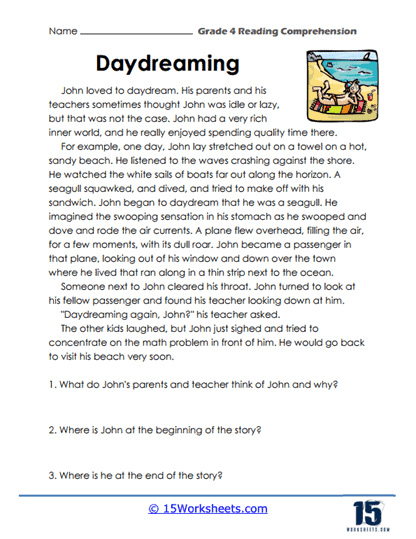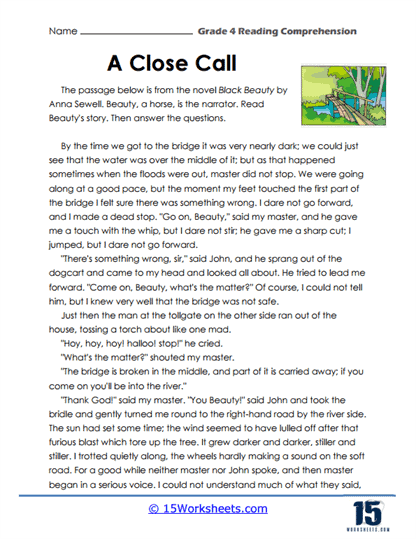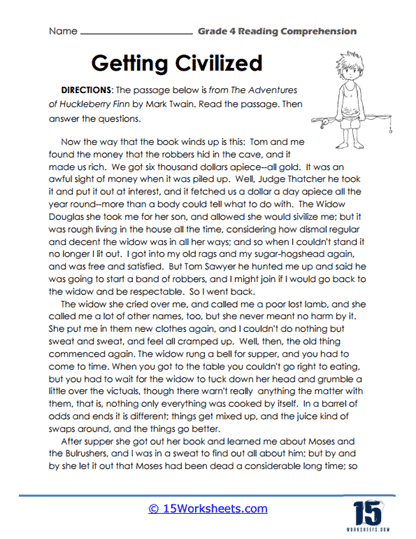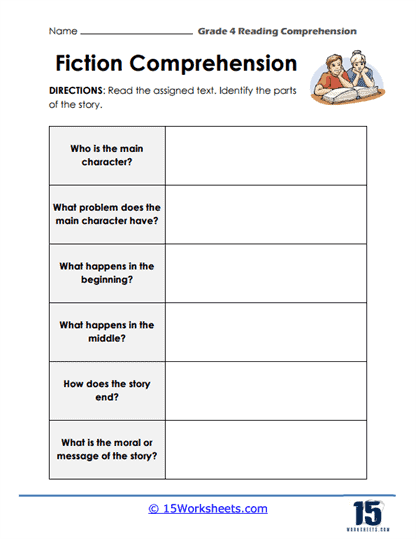Grade 4 Reading Comprehension Worksheets
All About These 15 Worksheets
In the world of education, reading comprehension is not just a fundamental skill-it is the cornerstone upon which all other academic abilities are constructed. For 4th grade students, mastering reading comprehension is more than an academic milestone; it represents a crucial phase in their development, setting the stage for success in all future learning endeavors. As these students transition from the early stages of “learning to read” to the more sophisticated process of “reading to learn,” their ability to comprehend and engage with texts becomes a pivotal part of their academic growth.
At this critical juncture, educators and parents alike seek effective tools to nurture and enhance these reading skills. Enter this collection of 15 thoughtfully designed reading comprehension worksheets, crafted specifically for 4th grade students. Each worksheet serves as a stepping stone in helping young learners not only improve their reading proficiency but also develop a deeper understanding of the texts they encounter. Through engaging activities and structured practice, these worksheets guide students on a journey that fosters not only reading comprehension but also critical thinking, creativity, and a lasting love for reading.
4th grade marks a unique and transformative year in a child’s educational journey. It’s the moment when students move from basic literacy-where they focus on decoding words and understanding simple texts-to a more complex relationship with reading. At this stage, comprehension becomes the focal point, and it is no longer sufficient for students to merely pronounce words correctly. Instead, they must now grasp the underlying meanings of texts, identify key themes, and extract critical information from both fiction and nonfiction. In essence, they evolve from passive readers to active learners, capable of analyzing and interacting with the material in meaningful ways.
Proficiency in reading comprehension extends beyond just doing well in language arts; it is a skill that impacts nearly every subject area. Whether it’s solving math problems that require understanding multi-step instructions or grasping scientific concepts presented in textbooks, strong reading skills underpin success across the board. Moreover, being able to comprehend what they read enables students to communicate more effectively, both in writing and verbally, as they learn to synthesize information and present it coherently.
This collection of worksheets addresses the critical need for 4th grade students to build strong reading comprehension skills at a time when it matters most. These worksheets are not mere exercises in reading-they are opportunities for students to explore new worlds through literature, engage with challenging texts, and sharpen their analytical skills. By working through these carefully designed passages and questions, students gain the confidence to tackle a variety of texts, whether they are reading a fictional story or absorbing information from nonfiction material.
At the 4th grade level, students are expected to confidently read a wide array of texts with fluency. They should be able to adjust their reading speed and tone depending on the nature of the material, whether it’s an exciting narrative or an informative article. Their vocabulary is expected to expand rapidly, allowing them to deduce the meanings of unfamiliar words using context clues, root words, and affixes. These students should be able to dive beneath the surface of a text, identifying not only the main idea but also the underlying themes, subtext, and literary devices such as metaphors, similes, and symbolism.
Critical thinking becomes an essential component of their reading journey. As students progress, they should develop the ability to recognize an author’s intent, differentiate between fact and opinion, and discern between literal and figurative language. Furthermore, their comprehension skills will allow them to compare and contrast characters, settings, and plotlines across multiple texts, honing their analytical abilities in the process. This skillset will prove invaluable as they are increasingly asked to synthesize information from various sources and present their findings through written reports, essays, or oral presentations.
These worksheets are designed with the specific goal of helping students practice and improve their ability to understand what they read. Each worksheet typically presents a carefully selected passage-sometimes a fictional story, sometimes a piece of nonfiction-and follows it with a series of questions aimed at testing different aspects of comprehension.
In many cases, the questions will start with straightforward inquiries about the text. These might be multiple-choice questions that ask students to recall specific details such as the names of characters, the sequence of events, or key facts from the passage. This kind of questioning is designed to ensure that students are paying attention to the text and can retain information, an important foundational skill.
However, the true value of these worksheets lies in their ability to push students beyond basic recall. Many of the questions require students to engage in higher-order thinking, asking them to make inferences, draw conclusions, or predict what might happen next in the story. These kinds of questions encourage students to think critically and actively engage with the material, rather than passively consuming information. For instance, a student might be asked to explain the significance of a character’s actions or to identify the central theme of a nonfiction passage.
Vocabulary-building questions often form an integral part of these worksheets. Students may be introduced to new words and asked to determine their meanings from the surrounding context or to use these words in their own sentences. This not only improves their vocabulary but also enhances their ability to decipher challenging texts in the future.
These worksheets serve as a bridge between basic reading and the more advanced literacy skills that will carry students through middle school, high school, and beyond. By providing structured practice in reading comprehension, they help 4th graders develop the confidence and proficiency needed to become lifelong readers and learners. Ultimately, reading comprehension is not just about understanding words on a page; it’s about unlocking new knowledge, exploring different perspectives, and preparing for the complex world of ideas that lies ahead.
What Reading Skills Do 4th Graders Learn?
In 4th grade, students typically focus on developing and strengthening several critical reading skills, building on the foundations established in earlier grades. While this can vary somewhat depending on the specific curriculum and individual pace of the student, here are some of the primary reading skills often emphasized in the 4th grade:
Comprehending Complex Texts
In the 4th grade, students start to read more challenging texts that may have complex sentences and contain more sophisticated vocabulary. They learn to follow longer, multistep procedures, and understand some nuances of language. Students are often encouraged to make inferences based on what they’ve read and to predict what might happen next. They learn to use context clues, their knowledge from the text, and their personal experience to make reasonable predictions and inferences.
Main Idea and Details
By 4th grade, students are expected to be able to identify the main idea of a text, understand its supporting details, and summarize the text concisely. Students begin to compare and contrast themes, settings, and plots of stories written by the same author or about the same or related topics. Students begin to understand figurative language, such as metaphors and similes, as well as idioms, adages, and proverbs.
Elements of a Story
Students are often taught to analyze elements of a story, such as character development, setting, plot, and theme. They might also discuss the author’s purpose and perspective. Students start to learn how to critically analyze texts, evaluate arguments, and assess the use of evidence. They are also expected to provide a logical explanation of their thinking. Students will often learn about different text structures (e.g., cause/effect, problem/solution, sequence) and how to use these structures to aid comprehension.
What Reading Skills Should 4th Grade Students Have Mastered?
By the end of the 4th grade, students should have mastered a range of reading skills. These skills contribute to their overall literacy development and prepare them for more advanced comprehension and analysis in later grades. Here’s a list of reading skills that 4th graders should have typically mastered:
They should have an extensive vocabulary and use context clues to determine the meaning of words or phrases. They should understand and apply knowledge of language structure, word relationships, and nuances in word meanings. Students should read with appropriate speed, accuracy, and expression. They should be able to use phrasing and intonation to reflect comprehension. They should be capable of comprehending a range of literature including stories, dramas, and poetry, as well as informational texts.
Inference – They should make inferences about texts and cite textual evidence to support conclusions drawn from the text.
Theme and Main Idea – They should be able to determine a theme or main idea of a story, play, or poem and explain how it is supported by key details in the text.
Characters, Settings, and Events – They should describe in depth characters, settings, and events in a story or drama, drawing on specific details in the text.
Compare and Contrast – They should have the ability to compare and contrast the point of view from which different stories are narrated, including the difference between first- and third-person narrations.
Text Structure – They should understand and be able to describe how a text is structured, including how sentences, paragraphs, and larger portions of the text connect and build on each other.
Integrating Information – They should be able to interpret information presented visually, orally, or quantitatively, and explain how the information contributes to an understanding of the text.
Read and Comprehend – They should be capable of reading and comprehending literature and informational texts at the high end of the grades 4-5 text complexity band independently and proficiently.
It’s important to note that students develop at their own pace, and these are general guidelines. Some students might master these skills earlier or later than 4th grade.
Overall, this is not merely a collection of worksheets; it is a comprehensive resource that empowers fourth-grade students to develop strong reading comprehension skills, setting them on a path toward academic excellence and a lifelong passion for reading.
By nurturing critical thinking, vocabulary growth, and a deep connection with literature, this collection equips students with the tools they need to excel in their studies and become enthusiastic, capable readers.
A 4th grade student can improve reading comprehension by regularly practicing active reading, which involves pausing to summarize sections of text and asking themselves questions about the material. They should cultivate the habit of underlining or highlighting key details, main ideas, and unfamiliar vocabulary in texts. Engaging in discussions about readings with peers, parents, or teachers can further deepen understanding and perspective. It’s beneficial to diversify reading materials, exploring various genres and formats, which exposes the student to different structures and broadens vocabulary. Using graphic organizers, such as story maps or Venn diagrams, can help students visualize connections and main points in a text. Finally, consistently writing short summaries or reflections on reading passages can cement understanding and foster the ability to distill the essence of a text.
These worksheets underscore the enduring importance of reading comprehension as a foundation for lifelong learning and success, making it an invaluable asset for educators, parents, and young learners alike.



